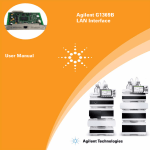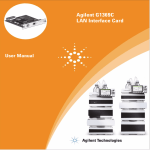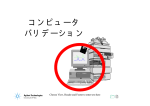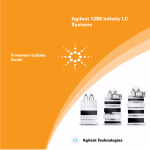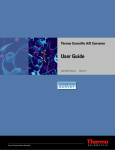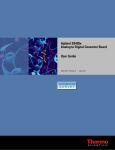Download Agilent Technologies 1100 Series Technical information
Transcript
LC Devices Agilent 1100 Series Connecting the Hardware and Triggering Data Acquisition XCALI-97190 Revision C January 2009 © 2009 Thermo Fisher Scientific Inc. All rights reserved. Agilent is a registered trademark of Agilent Technologies Inc. Hewlett Packard is a registered trademark of Hewlett Packard Company. LCQ, LTQ, LXQ, MSQ, TSQ, and Xcalibur are trademarks of Thermo Fisher Scientific Inc. in the United States. Thermo Fisher Scientific Inc. provides this document to its customers with a product purchase to use in the product operation. This document is copyright protected and any reproduction of the whole or any part of this document is strictly prohibited, except with the written authorization of Thermo Fisher Scientific Inc. The contents of this document are subject to change without notice. All technical information in this document is for reference purposes only. System configurations and specifications in this document supersede all previous information received by the purchaser. Thermo Fisher Scientific Inc. makes no representations that this document is complete, accurate or errorfree and assumes no responsibility and will not be liable for any errors, omissions, damage or loss that might result from any use of this document, even if the information in the document is followed properly. This document is not part of any sales contract between Thermo Fisher Scientific Inc. and a purchaser. This document shall in no way govern or modify any Terms and Conditions of Sale, which Terms and Conditions of Sale shall govern all conflicting information between the two documents. Release history: Revision A February 2007, Revision B July 2007, Revision C January 2009 Software versions supported: LC Devices 2.0.2 to 2.2.1 Firmware version supported: A.06.01 (012) For Research Use Only. Not regulated for medical or veterinary diagnostic use by U.S. Federal Drug Administration or other competent authorities. C Contents Preface . . . . . . . . . . . . . . . . . . . . . . . . . . . . . . . . . . . . . . . . . . . . . . . . . . . . . . . . . . . . . . .v Related Documentation . . . . . . . . . . . . . . . . . . . . . . . . . . . . . . . . . . . . . . . . . . . v Safety and Special Notices . . . . . . . . . . . . . . . . . . . . . . . . . . . . . . . . . . . . . . . . . v Safety Precautions. . . . . . . . . . . . . . . . . . . . . . . . . . . . . . . . . . . . . . . . . . . . . . . .vi Contacting Us . . . . . . . . . . . . . . . . . . . . . . . . . . . . . . . . . . . . . . . . . . . . . . . . . vii Chapter 1 Agilent Modules Supported by LC Devices Versions 2.0.2 to 2.2.1 . . . . . . . . . . . .1 Chapter 2 Connecting the Hardware . . . . . . . . . . . . . . . . . . . . . . . . . . . . . . . . . . . . . . . . . . . . . . .3 Ethernet Communication Kit . . . . . . . . . . . . . . . . . . . . . . . . . . . . . . . . . . . . . . . 3 Installing a Network Card in an Agilent Module. . . . . . . . . . . . . . . . . . . . . . . . . 4 Connecting the Ethernet Communication Cables . . . . . . . . . . . . . . . . . . . . . . . . 7 Installing the External Contact Interface Board . . . . . . . . . . . . . . . . . . . . . . . . . . 8 Connecting the Trigger Cable . . . . . . . . . . . . . . . . . . . . . . . . . . . . . . . . . . . . . . . 9 Chapter 3 Specifying the TCP/IP Settings and the BCD Board Location. . . . . . . . . . . . . . . .11 Assigning Contact Closure Control to the Autosampler . . . . . . . . . . . . . . . . . . 11 Specifying the TCP/IP Settings . . . . . . . . . . . . . . . . . . . . . . . . . . . . . . . . . . . . . 12 Chapter 4 Triggering Data Acquisition with the Autosampler . . . . . . . . . . . . . . . . . . . . . . . .15 Chapter 5 Turning Off the Solvent Tracking Feature. . . . . . . . . . . . . . . . . . . . . . . . . . . . . . . . .17 Appendix A Upgrading an HP 1100 Series LC . . . . . . . . . . . . . . . . . . . . . . . . . . . . . . . . . . . . . . . .19 Index . . . . . . . . . . . . . . . . . . . . . . . . . . . . . . . . . . . . . . . . . . . . . . . . . . . . . . . . . . . . . . . .21 Thermo Scientific Agilent 1100 Series Connecting the Hardware and Triggering Data Acquisition iii P Preface This guide describes how to physically connect an Agilent™ 1100 Series LC to a Thermo Scientific mass spectrometer and the data system computer, configure an Agilent autosampler for contact closure from within the Xcalibur Instrument Configuration program, and trigger data collection with an Agilent autosampler. This guide also describes how to upgrade a Hewlett Packard™ 1100 Series LC to an Agilent 1100 Series LC with Ethernet communication. Related Documentation In addition to this guide, Thermo Fisher Scientific provides Help available from within the Xcalibur software. Safety and Special Notices Make sure you follow the precautionary statements presented in this guide. The safety and other special notices appear in boxes. Safety and special notices include the following: CAUTION Highlights hazards to humans, property, or the environment. Each CAUTION notice is accompanied by an appropriate CAUTION symbol. CAUTION Highlights electric shock related hazards to human beings. Each electric shock notice is accompanied by the international High Voltage symbol. IMPORTANT Highlights information necessary to prevent damage to software, loss of data, or invalid test results; or might contain information that is critical for optimal performance of the system. Note Highlights information of general interest. Thermo Scientific Agilent 1100 Series Connecting the Hardware and Triggering Data Acquisition v Preface Tip Helpful information that can make a task easier. Safety Precautions To connect the Agilent 1100 Series LC stack to a Thermo Scientific mass spectrometer, you must install an external contact board in one of the Agilent modules and a LAN interface board in a second Agilent module. To install a board, you must remove the cover from the optional board slot. Figure 2 on page 6 shows the location of the slot on the back panel of the detector. Before you remove the slot cover from an Agilent 1100 Series module, do the following: • Turn the power switch to the Off position and unplug the power cable. CAUTION To avoid an electric shock, always turn off an Agilent module and unplug it from line power before you remove its cover. • Refer to the reference manual for the module for additional safety information and for information on preventing ESD damage caused by an electrical discharge. CAUTION To prevent damage to an instrument, always use ESD protection when handling electronic boards and components. vi Agilent 1100 Series Connecting the Hardware and Triggering Data Acquisition Thermo Scientific Preface Contacting Us There are several ways to contact Thermo Fisher Scientific for the information you need. Y To contact Technical Support Phone Fax E-mail Knowledge base 800-532-4752 561-688-8736 [email protected] www.thermokb.com Find software updates and utilities to download at mssupport.thermo.com. Y To contact Customer Service for ordering information Phone Fax E-mail Web site 800-532-4752 561-688-8731 [email protected] www.thermo.com/ms Y To copy manuals from the Internet Go to mssupport.thermo.com and click Customer Manuals in the left margin of the window. Y To suggest changes to documentation or to Help • Complete a brief survey about this document by clicking the link below. Thank you in advance for your help. • Send an e-mail message to the Technical Publications Editor at [email protected]. Thermo Scientific Agilent 1100 Series Connecting the Hardware and Triggering Data Acquisition vii 1 Agilent Modules Supported by LC Devices Versions 2.0.2 to 2.2.1 Table 1 lists the model number and firmware versions for the Agilent 1100 Series LC modules that are supported by the Xcalibur 2.0 and higher data system. Table 1. Xcalibur supported firmware versions for the Agilent 1100 Series LC Module Model Number Firmware Version Binary pump G1312A A.06.01 (012) Quaternary pump G1311A A.06.01 (012) Autosampler G1313A A.06.01 (012) Thermostatted autosampler G1329A A.06.01 (012) Well-plate autosampler G1367A A.06.01 (012) Thermostatted column compartment G1316A A.06.01 (012) Variable wavelength detector G1314A A.06.01 (012) G1315A A.06.01 (012) G1365B A.06.01 (012) Diode-array detector Multiple wavelength detector * * Only works with version B of the Control Module. Y To check the firmware version of an Agilent 1100 module 1. Make sure that the Agilent 1100 Series modules are connected by CAN communication cables, that all the modules are turned on, and that the Agilent 1100 Control Module is connected. Refer to the Agilent 1100 Series LC reference manuals for instructions on how to connect the CAN cables. 2. Press the Esc key on the Control Module until System appears in the upper-left corner of the LCD display. 3. Press the F4 key on the Control Module to access the Records LCD display. Thermo Scientific Agilent 1100 Series Connecting the Hardware and Triggering Data Acquisition 1 1 Agilent Modules Supported by LC Devices Versions 2.0.2 to 2.2.1 Time Records Module Product Serial# Version Ready On-time EMF 4. Check the firmware versions of the Agilent 1100 Series modules. Refer to Table 1 for the firmware versions supported by the Xcalibur 2.0. and higher data system. 2 Agilent 1100 Series Connecting the Hardware and Triggering Data Acquisition Thermo Scientific 2 Connecting the Hardware This chapter describes how to install the interface boards, connect the Ethernet cables, and make the contact closure connections required to control an LC/MS system (Agilent LC/Thermo scientific MS) system from Xcalibur. Contents • Ethernet Communication Kit • Installing a Network Card in an Agilent Module • Connecting the Ethernet Communication Cables • Installing the External Contact Interface Board • Connecting the Trigger Cable Ethernet Communication Kit To connect an Agilent 1100 series HPLC to your Thermo Scientific MS detector, you must have the Ethernet Communication kit (P/N OPTON-30012), which contains the parts listed in Table 2. In addition, one of the modules of the Agilent 1100 Series LC must have a JetDirect 400N LAN card (P/N 00825-01140) or an Agilent LAN interface board, model number G1369A. Table 2. Ethernet Communication kit (P/N OPTON 30012) Thermo Scientific Description Part Number Ethernet switch 00825-01-00024 PCB, Agilent BCD board 00012-27714 Cable, trigger external contact, 2-wire DB15 00012-27716 Cable, patch, 3 m (10 ft) CAT5 RJ45, straight shield 00012-70008 Agilent 1100 Series Connecting the Hardware and Triggering Data Acquisition 3 2 Connecting the Hardware Installing a Network Card in an Agilent Module Installing a Network Card in an Agilent Module For the Agilent LC system to communicate with the Xcalibur data system through an Ethernet connection, one of the modules in the Agilent 1100 Series LC stack must have a network interface card. If the stack has a detector, the card is usually installed in the detector. Tip Vendors label network cards with a unique MAC address, which is a 12-digit hexadecimal number. The first portion of the MAC address identifies the vendor. The second portion of the MAC address is a unique serial number. For example, a typical mark on a network card is AD: 0030C1C49982, in which 0030C1C49982 is the stack MAC address. The first portion, 0030C1, identifies the vendor as Hewlett-Packard. The MAC address of the HP JetDirect 400N network card is located on the back of the card. Because you need the MAC address when you configure the Agilent stack, record the network card MAC address before you install the card. Agilent 1100 Series LC systems with JetDirect™ network cards must have revision 2 mainboards to function properly with LAN communications. Table 3 shows the required revision level for each module. The serial number listed in the table and all serial numbers after that number are supported. Table 3. Supported serial number * 4 Module P/N (Mainboard) Serial Numbers for Supported Version * G1310A Isocratic pump G1311-65520 DE64300355 (made in Germany) US64400233 (made in U.S.A.) G1311A Quaternary pump G1311-65520 DE64301137 (made in Germany) US64401134 (made in U.S.A.) G1312A Binary pump G1312-65520 DE64300703 (made in Germany) US64400425 (made in U.S.A.) G1313A ALS autosampler G1313-65520 DE64302092 (made in Germany) US64400886 (made in U.S.A.) G1314A Variable wavelength detector G1314-65520 JP64201926 (made in Japan) G1315A Diode array detector G131-65520 DE64301532 (made in Germany US64400333 (made in U.S.A.) All serial numbers above the listed number in numeric order are supported Agilent 1100 Series Connecting the Hardware and Triggering Data Acquisition Thermo Scientific 2 Connecting the Hardware Installing a Network Card in an Agilent Module Y To install the network interface card in an Agilent module 1. Make sure the module (usually the detector) is turned off and unplugged from line power. Figure 1 shows the location of the power switches. When the power switch of a module is in the On position, the LED on the switch is green. When you turn the power switch of a module to the Off position, the LED turns off. If your LC stack contains a detector (for example, diode-array detector, variable wavelength detector, multiple wavelength detector), install the network interface card in the detector. If your LC stack does not contain a detector, install the network card in any module with an open slot. CAUTION To avoid electric shock, unplug the power cable that connects the Agilent module to line power. After you turn the power switch to the Off position, the power supply continues to draw current. Tip You can install an Agilent LAN interface board (model G1369A) instead of a JetDirect 400N network card. Figure 1. Front panels of the Agilent 1100 Series modules Solvent cabinet 1100 Series Binary pump Power switch 1100 Series F8 F7 F6 m Esc F2 F3 F4 7 8 9 4 5 6 1 2 3 0 . - ◄ F5 ◄ F1 i Enter Autosampler Power switch 1100 Series Column compartment Power switch 1100 Series Detector Power switch On position Thermo Scientific Off position Agilent 1100 Series Connecting the Hardware and Triggering Data Acquisition 5 2 Connecting the Hardware Installing a Network Card in an Agilent Module 2. To prevent damage to the interface board, ensure that you are using ESD protection. For more information on preventing damage caused by an electric discharge, refer to the Reference Manual for the Agilent module. CAUTION To prevent damage to an instrument, always use ESD protection when handling electronic boards and components. 3. To remove the cover plate from the slot where you plan to install the network interface card, loosen the two screws that fasten the plate to the chassis of the module. Figure 2 shows the location of the cover plate on the back panel of an Agilent 1100 Series detector. Figure 2. Back panel of an Agilent 1100 Series detector Cover plate ANALOG ANALOG RS232 RS232 CAN CAN 4. Record the MAC address (12-digit hexadecimal number) located on the back of the HP JetDirect 400N network card. You use this number to complete the configuration of the Agilent stack (see Figure 6 on page 12). 5. Insert the HP JetDirect 400N network card into the slot, and then tighten the two screws that fasten the PCB to the chassis of the module. 6 Agilent 1100 Series Connecting the Hardware and Triggering Data Acquisition Thermo Scientific 2 Connecting the Hardware Connecting the Ethernet Communication Cables Connecting the Ethernet Communication Cables Y To connect the Ethernet communication cable to an Agilent 1100 Series LC 1. Connect a category 5, shielded Ethernet cable from the JetDirect 400N network card to the Ethernet switch. CAUTION To comply with safety and EMC regulations, you must use category 5, shielded Ethernet cables to make the Ethernet connections for your instrument. 2. Connect a category 5, shielded Ethernet cable from the Ethernet switch to the Ethernet card in the computer dedicated to the LC system (typically network interface card number 3). Figure 3 shows the Ethernet connections. BNC 100 (RJ-45) HEWLETT PACKARD JET DIRECT 400N BNC 100 (RJ-45) JET DIRECT 400N Ethernet connections HEWLETT PACKARD Figure 3. JetDirect 400N card (installed in one of the Agilent modules) Computer Optiplex GX520 (subject to change) Not drawn to scale USB ENET Ethernet Switch Cat5 shielded Ethernet cables Thermo Scientific Agilent 1100 Series Connecting the Hardware and Triggering Data Acquisition 7 2 Connecting the Hardware Installing the External Contact Interface Board Installing the External Contact Interface Board If your Agilent 1100 Series Autosampler is not already equipped with an external contact interface board, install one as described below. Y To install the external contact interface board 1. If you have not already done so, turn off the autosampler and unplug it from line power. CAUTION To avoid electric shock, unplug the power cable that connects the Agilent module to line power. After you turn the power switch to the Off position, the power supply continues to draw current. 2. To prevent damage to the interface board, ensure that you are using ESD protection. For more information on preventing damage caused by an electric discharge, refer to the Reference Manual for the Agilent module. CAUTION To prevent damage to an instrument, always use ESD protection when handling electronic boards and components. 3. To remove the cover plate from the slot where you plan to install the external contact interface board, loosen the two screws that fasten the plate to the chassis of the autosampler. 4. Insert the external contact interface board (see Table 2 for the part number) into the slot, and then tighten the two screws to fasten the board to the chassis of the autosampler. Figure 4 shows an installed external contact interface board. Figure 4. View of the external contact interface board installed in an Agilent 1100 Series autosampler Screws for fastening the external contact interface board VIAL- # -OUTPUT RELAY CONTACTS 1 REMOTE RS232 8 CAN Agilent 1100 Series Connecting the Hardware and Triggering Data Acquisition CAN HP-1B 8 CONFIG Thermo Scientific 2 Connecting the Hardware Connecting the Trigger Cable Connecting the Trigger Cable A trigger cable with a DB15 connector relays the start signal from the autosampler to the MS detector. Y To connect the trigger cable to the Agilent autosampler and the MS detector 1. If you have not already done so, install the external contact interface board as described in “Installing the External Contact Interface Board.” 2. Connect the 2-pin connector to the I/O panel of the MS detector, such that the white wire is connected to the Start In+ pin and the brown wire is connected to the Start In– pin. 3. Connect the DB15 connector to the RELAY CONTACTS receptacle located on the external contact interface board of the Agilent 1100 Series autosampler (see Figure 5). Thermo Scientific Agilent 1100 Series Connecting the Hardware and Triggering Data Acquisition 9 2 Connecting the Hardware Connecting the Trigger Cable Figure 5. Connections for 2-wire, DB15 trigger cable (Right-side panel) TSQ Series MS detector (Rear panel) START IN Connection to autosampler LXQ or LTQ MS detector (Right-side panel) RELAY CONTACTS White wire Brown wire START IN +- LCQ Series (Rear panel) Peripheral Control START IN + – (5V Max) (5V Max) (Left-side panel) Surveyor MSQ (Rear panel) Start In + Start In - Not drawn to scale 10 Agilent 1100 Series Connecting the Hardware and Triggering Data Acquisition Trigger Cable Thermo Scientific 3 Specifying the TCP/IP Settings and the BCD Board Location The Agilent 1100 Series devices query the PC for the stack IP address only during their start up procedure. Therefore, complete the following procedure, and ensure that the Xcalibur Home Page window is open before you turn on the Agilent 1100 Series devices. Contents • Assigning Contact Closure Control to the Autosampler • Specifying the TCP/IP Settings Assigning Contact Closure Control to the Autosampler Y To assign contact closure control to the Agilent 1100 Series autosampler 1. Depending on the Xcalibur data system version, do one of the following: • Choose Start > All Programs > Xcalibur > Instrument Configuration. The Instrument Configuration dialog box appears. • Choose Start > All Programs > Thermo Foundation 1.0 > Instrument Configuration. The Thermo Foundation Instrument Configuration dialog box appears. 2. In the Available Devices area, double-click the Agilent 1100 AS button. A copy of the Agilent 1100 AS button appears in the Configured Devices area. 3. In the Configured Devices area, double-click the Agilent 1100 AS button. The Agilent 1100 Autosampler dialog box appears. 4. Click the General tab. The General page appears (see Figure 6 on page 12). Thermo Scientific Agilent 1100 Series Connecting the Hardware and Triggering Data Acquisition 11 3 Specifying the TCP/IP Settings and the BCD Board Location Specifying the TCP/IP Settings 5. In the General page, select the Contact Board Installed check box. Note If you do not select the Contact Board Installed check box, the Timed Events page does not appear in the Instrument Setup view for the autosampler. 6. Do one of the following: • If you have not already specified the TCP/IP settings for the Agilent 1100 Series stack, leave the General page open and go to the next procedure. • If you have finished specifying the configuration options for the stack, click OK to save the settings and close the dialog box. Click Done to exit the Xcalibur Instrument Configuration program. Open the Xcalibur data system before you turn on the devices of your Agilent1100 Series LC stack. Specifying the TCP/IP Settings Y To specify the TCP/IP settings for the Agilent 1100 Series stack 1. From the Instrument Configuration window, open the General page for the autosampler (Figure 6). Figure 6. Agilent1100 Autosampler dialog box 12-digit hexadecimal number located on the back of the HP JetDirect network card 2. In the TCP/IP area, do the following: • In the Stack MAC address box, type the media access control address for your Agilent LC stack. The stack MAC address is a unique identification for each network card. The manufacturer usually stamps it on the network card. 12 Agilent 1100 Series Connecting the Hardware and Triggering Data Acquisition Thermo Scientific 3 Specifying the TCP/IP Settings and the BCD Board Location Specifying the TCP/IP Settings Note The TCP/IP settings are shared by all Agilent 100 LC modules in the stack. Changing the value of a setting for one module in the Instrument Configuration dialog box changes the value of that setting for all modules in the stack. • In the Stack IP Address box, type the IP address for your Agilent 1100 LC stack. Leave the value set to the default or contact your network administrator for the IP address. The default stack IP address is 172.16.0.102. • In the Sub-mask box, type the subnet mask (address mask). Leave the subnet mask set to its default value, or contact your network administrator for the subnet mask. The default subnet mask value is 255.255.255.0. • In the Bootp Server box, type the IP address for the network card in your PC that is responsible for assigning the stack IP address for your Agilent 1100 LC system. Leave the value set to the default or contact your network administrator for the BOOTP server IP address. The default IP address for the network card is 172.16.0.101. 3. Click OK to save the settings and close the dialog box. 4. Click Done to close the Xcalibur Instrument Configuration window. 5. Open the Xcalibur data system before you turn on the devices of your Agilent1100 Series LC stack. Thermo Scientific Agilent 1100 Series Connecting the Hardware and Triggering Data Acquisition 13 4 Triggering Data Acquisition with the Autosampler If you want the Agilent 1100 series autosampler to trigger data acquisition, you must make the appropriate selections in the Timed Events page for the autosampler for each instrument method you create. Instrument methods contain the contact closure signals, the chromatographic conditions, and the MS detector settings for an LC/MS application. Note Configure the Agilent 1100 Series autosampler before performing the following procedure. Refer to Chapter 3, “Specifying the TCP/IP Settings and the BCD Board Location,” Y To trigger data acquisition with the Agilent 1100 Series autosampler 1. Choose Start > All Programs > Xcalibur (or Thermo Xcalibur) > Xcalibur. The Home Page appears. 2. Click the Instrument Setup button. The Instrument Setup window appears. 3. Click the Agilent 1100 AS button in the Instrument Setup viewbar located on the left side of the window. The Instrument Setup view for the Agilent 1100 AS appears. 4. Click the Timed Events tab. The Timed Events page appears. 5. In the Timed Events page, select the appropriate contact closure signal settings as shown in Figure 7. a. Click the Contact 1 box to display the list and select Closed. b. Make sure that all the other Contact boxes display Open. Figure 7. Thermo Scientific Timed Events page for the Agilent 1100 Series autosampler Agilent 1100 Series Connecting the Hardware and Triggering Data Acquisition 15 4 Triggering Data Acquisition with the Autosampler 6. Make the appropriate entries and selections for the rest of the instrument method. 7. Save your method with an appropriate name. 8. Choose File > Exit to close the Instrument Setup window. Xcalibur prompts you with the Save As dialog box, the File Summary Information Dialog box, and the File Save - Audit Trail dialog box. 16 Agilent 1100 Series Connecting the Hardware and Triggering Data Acquisition Thermo Scientific 5 Turning Off the Solvent Tracking Feature The solvent tracking feature on the Agilent 1100 LC pumps is not supported by Xcalibur at this time. You must turn off this feature to prevent error messages from terminating the data acquisition. Y To turn off the solvent tracking feature on the Agilent 1100 pump 1. If Xcalibur is open, close it. 2. Open the Analysis screen on the Agilent 1100 handheld control module. Figure 8 shows the control module. 3. Press the Settings button F1. Figure 8. Agilent 1100 handheld control module F8 F7 F6 m Esc F2 F3 F4 7 8 9 4 5 6 1 2 3 0 . - ◄ F5 ◄ F1 i Enter 4. Press the number corresponding to the pump. 5. Press the Bottle Fillings button F4. 6. Set all of the solvent Total boxes to 0. The solvent Actual boxes are then automatically set to 0. Thermo Scientific Agilent 1100 Series Connecting the Hardware and Triggering Data Acquisition 17 5 Turning Off the Solvent Tracking Feature 7. Clear the Error If Empty check box by using the right arrow to move the focus to this setting, and then pressing Enter. 8. Press the Done button F6. 9. From the data system computer, open the Information View of the Xcalibur Home Page. The Agilent 1100 devices should reconnect and appropriately display their status. 10. If the Info view is not displayed, from the menu bar, choose View > Info View. 18 Agilent 1100 Series Connecting the Hardware and Triggering Data Acquisition Thermo Scientific A Upgrading an HP 1100 Series LC The Xcalibur 2.0 and higher data system supports control of the Hewlett-Packard (HP) 1100 Series LC only if you upgrade the HP 1100 communication interface to an Ethernet interface. Y To upgrade your HP 1100 Series LC 1. Order the appropriate upgrade parts from your local office for Thermo Scientific San Jose products: • If the HP 1100 is not interfaced to an MS detector as an Xcalibur-controlled GPIB inlet device, order the JetDirect Ethernet Control Kit. This kit contains the parts listed in Table 4. • If the HP 1100 is interfaced to an MS detector as an Xcalibur-controlled GPIB inlet device, order the parts listed in Table 5. Note An HP 1100 LC system that is currently interfaced to a MS detector as an Xcalibur-controlled GPIB inlet device should have already installed the contact closure PCB and the external contact closure cable. Therefore, you need to order only the parts specified in Table 5. Table 4. JetDirect Ethernet Control Kit (P/N OPTON 30018) Thermo Scientific Part Number Description of Kit 00012-27714 Contact closure PCB 00012-27716 External contact closure cable 00012-70008 Ethernet 10 Base-T cable (2) 00825-01-00024 10/100 Autosensing 8-port Ethernet switch 00825-01140 HP JetDirect 400N PCB Agilent 1100 Series Connecting the Hardware and Triggering Data Acquisition 19 A Upgrading an HP 1100 Series LC Table 5. Parts required to upgrade an Xcalibur-controlled HP 1100 Series LC Part Number Description of Part 00825-01140 HP JetDirect 400N PCB 00012-70008 Ethernet 10 Base-T cable (2) 00825-01-00024 Ethernet switch 2. Follow the instructions in “Installing a Network Card in an Agilent Module” on page 4 to install the JetDirect 400N PCB. Note After the communication interface in the HP 1100 LC system is upgraded to an Ethernet interface, the system is the same as, and will be referred to as, an Agilent 1100 LC system. 20 Agilent 1100 Series Connecting the Hardware and Triggering Data Acquisition Thermo Scientific I Index A M Agilent 1100 Series LC configuring autosampler for contact closure 11 external contact interface PCB, installing 8 solvent tracking feature, deactivating 17 supported mainboards for JetDirect cards 4 Agilent LAN interface board (G1369A) 5 MAC address 4, 12 mainboards supported for JetDirect Cards 4 C configuring the Agilent 1100 Series Autosampler 11 contact board 12 contact closure, configuring the Agilent Autosampler for 11 S safety precautions vi slot cover, removing from an Agilent module vi solvent tracking feature for Agilent pumps 17 stack IP address 13 stack MAC address 4, 12 T D TCP/IP settings 12 data acquisition, triggering 15 deactivating the solvent tracking feature for Agilent 1100 LC pumps 17 X E Xcalibur data system Instrument Configuration program, configuring the Agilent 1100 series autosampler for contact closure 11 Instrument Setup view 15 Electric shock safety precaution 5, 8 ESD precaution vi, 6, 8 Ethernet cable connections 7 Ethernet card for upgrading HP 1100 LC 19 F firmware for Agilent LC 1 H HP 1100 Series LC, upgrading to Ethernet interface 19 I instrument methods, triggering data acquisition 15 J JetDirect boards, supported 4 Thermo Scientific Agilent 1100 Series Connecting the Hardware and Triggering Data Acquisition 21
































